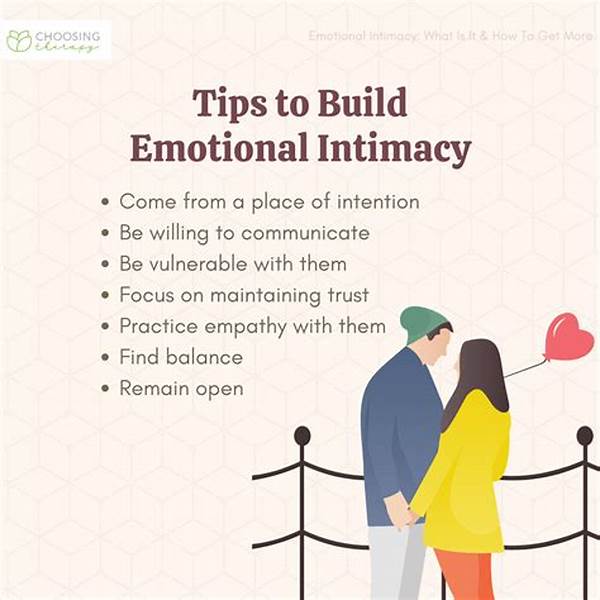
Emotional Intimacy In Therapeutic Settings
- Daniel Anderson
- 0
- Posted on
Emotional intimacy in therapeutic settings is a nuanced subject that holds a pivotal role in the success of therapy. It’s not just about exchanging words or understanding feelings superficially; it’s about forming a deep, trusting connection between therapist and client. This connection forms the foundation upon which therapeutic progress is built. As professionals navigate the intricate web of human emotions, developing emotional intimacy becomes essential. It’s fundamental to create a safe, non-judgmental space where clients feel comfortable sharing their innermost thoughts and emotions. In this setting, both therapist and client engage in an empathetic dance, finding balance and mutual understanding. Let’s delve deeper into the aspects and impact of emotional intimacy in therapeutic settings.
Read Now : Natural Ways To Ease Hangover Symptoms
Building Blocks of Emotional Intimacy
Building emotional intimacy in therapeutic settings is like crafting a work of art. You start with the basics—listening without judgment, validating the client’s feelings, and providing genuine empathy. The therapist’s ability to be authentic is key in this process. They need to show they’re human too, making small disclosures that can break down barriers. Trust ain’t something that happens overnight, it’s more like a slow-cooked stew, taking time and consistent effort to blossom. As clients begin to feel more understood and accepted, they open up, revealing layers of emotions that were once tucked away. Progress may not always be linear, but every step taken towards vulnerability is a triumph in the healing journey.
The Role of Trust
Trust is a biggie when developing emotional intimacy in therapeutic settings. Yup, you heard it right! Without trust, all else falls flat. A therapist has to work hard, earn it through honesty and reliability. Consistency in behavior and maintaining confidentiality builds this trust. Clients need assurance that their sensitive disclosures remain sacred. It’s all about creating a vibe where clients trust you enough to bring their raw, unfiltered selves to the table. Emotional intimacy in therapeutic settings thrives in this fertile ground of trust, as it allows the exploration of emotions with bold honesty.
Navigating Vulnerability
Let’s get real; vulnerability can be tough, but it’s at the heart of emotional intimacy in therapeutic settings. For clients, showing the parts of themselves they’ve kept hidden can feel like standing bare in the rain. But therapists encourage this openness, with supportive gestures and words, illuminating a path of healing. By modeling vulnerability themselves, therapists help clients see it’s okay to express their true feelings. It’s transformational! Slowly, both embark on a journey together, facing fears and clearing emotional roadblocks. In this space, vulnerability is nurtured and becomes a powerful force that fuels emotional growth.
Breaking Down Barriers
1. A Two-Way Street: Emotional intimacy in therapeutic settings is a give-and-take game. Both parties need to show up equally for it to work.
2. Oh, The Feels: Get comfy with your emotions; it’s a major player in therapy settings.
3. Real Talk: Dropping the therapist façade and getting on a real level with clients makes a huge difference.
4. Boundaries Still Matter: Emotional intimacy in therapeutic settings is vital, but maintaining boundaries keeps things professional.
Read Now : **water Consumption Enhances Focus**
5. Celebrate the Wins: Small victories in opening up should be celebrated as they build motivation and connection.
Listening with Empathy
Connecting with emotional intimacy in therapeutic settings isn’t just about hearing words; it’s about truly listening. When therapists embrace active listening, they pick up on subtleties in the client’s narrative—a tremble in voice, a pause laden with meaning. Empathy is the secret sauce, helping therapists echo the client’s feelings—and create a resonating bond that says, “I’ve been there.” It’s like they’re stepping into the client’s shoes, even if just for a moment. In this shared space, clients often feel valued, understood, and more willing to explore tough emotions. Emotional intimacy in therapeutic settings flourishes here, in the space between what’s said and what’s felt.
The Art of Patience
Patience, my friend, is a virtue, especially in therapeutic settings. Fostering emotional intimacy isn’t a race; it’s a marathon. Therapists have to pace themselves, understanding that clients open up in their own time, peeling back layers like an onion. It’s all about recognizing progress, even if it’s more of a simmer than a boil. With patience, therapists exemplify unwavering support, signalling to the client that they’re committed for the long haul. As trust grows stronger, so does emotional intimacy, allowing therapeutic breakthroughs to emerge naturally.
Navigating the Therapeutic Relationship
Navigating a therapeutic relationship requires finesse, understanding, and above all, a hefty dose of emotional intimacy. It’s about more than just sitting on opposite ends of a comfy chair, chatting about life’s ups and downs. Emotional intimacy in therapeutic settings is cultivated through genuine connection and a willingness to journey into emotional landscapes together. This trust-laden environment encourages client vulnerability, where they can explore difficult emotions without judgment. Therapists act as compassionate guides, helping clients navigate while honoring their experiences. It’s a journey that transforms both, unraveling layers of pain to find the whispered promises of healing within. The therapeutic alliance, rich in emotional intimacy, becomes a lighthouse for those navigating stormy emotional seas.
By engaging in these deep, emotional dialogues, therapists and clients co-create a space of safety and exploration. Emotional intimacy in therapeutic settings isn’t just about solving problems; it’s about evolving through them. It’s the kind of partnership where both therapist and client learn from each other, growing into better versions of themselves. This shared voyage eventually leads to not just tangible outcomes, but to a renewed sense of self-understanding, resilience, and hope. Ultimately, emotional intimacy in these settings paves the way for lasting change and a brighter, more empowered future.